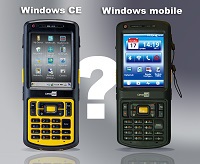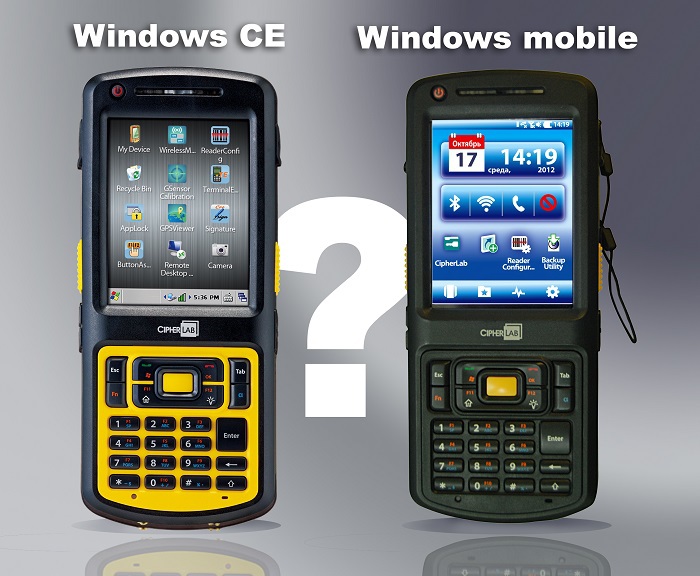Differences between Windows Mobile and Windows CE in data collection terminals
 Today, the market for data collection terminals on Windows continues to grow rapidly. This is because such devices are in demand in the automation of warehouse and logistics activities. Windows TSDs offer great opportunities for programming and solving various problems.
Today, the market for data collection terminals on Windows continues to grow rapidly. This is because such devices are in demand in the automation of warehouse and logistics activities. Windows TSDs offer great opportunities for programming and solving various problems. However, among devices there is another important difference - the type of system. The Windows operating system is divided into Windows Mobile and Windows CE. We will talk about the similarities and differences between these operating systems in this article, trying to figure out the advisability of choosing a particular version.
Market Overview
Among the most popular data collection terminals on Windows, a number of models can be distinguished, under the brands CipherLab, Motorola, Honeywell. Today, models for various purposes are actively produced, made in compact cases or, conversely, in a massive design for warehouse needs and a high class of protection (IP 65, IP66, IP67, etc.). By and large, their main tasks are very similar in many respects: folding accounting, inventorying, working with accounting programs, picking and shipping goods.
Advantages over DOS Terminals
- Filling and technical complexity .
Data collection terminals on Windows , in contrast to a simpler class of equipment - DOS terminals have more complex technical stuffing and options, such as an integrated photo and video camera, voice recorder, all kinds of wireless interfaces, etc. - Work on RDP .
Windows-terminals are equipped with large color displays with high resolution, which is very convenient for working on RDP (Remote Desktop Protocol). This allows you to perform tasks on your computer, and manage the process on the TSD screen to save resources, increase productivity and mobility.
Dos terminals are deprived of such an opportunity due to insufficient technical specifications. - Support .Net Compact Framework protocol.
The .NET Compact Framework is a set of components for launching applications on a data collection terminal or other mobile devices.
One of the advantages of CipherLab terminals over other brands is a well-thought-out application generator that configures the operation of the TSD (supplied). Before starting work with TSD, a warehouse employee can identify a number of algorithms on the computer (detailed information on barcodes, sorting by product groups, etc.), then synchronize the device with a PC and transfer all programmed conditions and data collection algorithms. Programming is based on the use of logic and does not require special knowledge. Libraries for Windows CE and Windows Mobile are different, which means the application generators will be different.

Windows Embedded Handheld
The Microsoft Windows Embedded operating system is designed on the Windows Mobile platform and belongs to the family of embedded OSs in various devices, including data collection terminals. The latest version today is Windows Embedded Handheld 6.5 (developed in 2010 and officially introduced in 2011). Due to its versatility and flexible architecture, Microsoft Windows Embedded can be used in POS terminals, mobile, embedded and portable devices.
A mandatory requirement of this OS is the availability of a good powerful hardware: processor, RAM, etc. Using such a system increases system requirements, and, as a result, the cost of the device itself increases.
The data collection terminals collected on Microsoft Windows Embedded OS include Cipher 9200 , Cipher CP30, Cipher 9600 and others. All these devices have PC communication software and work with 1C and an application generator supporting Windows Mobile.
Windows CE
Windows CE first appeared on the market back in 1996 as a compact version of Win95. Since then, a number of significant changes have taken place. Since 2000, this version of Windows began to develop and be implemented as an independent OS. The main emphasis was placed on creating components not for desktops, but for mobile devices, with application compatibility via the WIN32 API .
Windows CE and Windows Mobile are not interchangeable operating systems. A distinctive feature of Windows CE is a modular system, with support for various components, platforms, multitasking. The advantage of Windows CE is that this OS does not require serious resources for work and is designed for devices with a minimum amount of memory and a simple single-core processor (the minimum required for the system kernel to work is only 32 KB!).
The latest version to date is Windows CE Compact 7.0. Among the most popular data collection terminals on Windows CE, released recently, it should be noted Cipher 9700, Cipher CP55. Current trends in the release of equipment for automation suggest the availability of different versions so that the client can choose what is needed to solve the tasks of his company. So, some TSD models are available in several versions on both platforms. A vivid example of such devices can be considered the warehouse industrial terminal for data collection Cipher CP60.
Summing up: so what to choose?
In terms of speed, these 2 systems are almost completely identical, although earlier programs and applications on Windows CE worked much faster. Today, data collection terminals are equipped with powerful productive processors, a large amount of RAM and a significant difference in the work of a simple user is unlikely to be felt.
In general, Windows CE itself is simpler in its architecture and has a classic desktop interface (Start button, etc.). This OS is primarily interesting for developers.
Nevertheless, it is very good and advisable from the point of view of manufacturers to produce modern data collection terminals on the Windows CE operating system, despite the high popularity of Windows Handheld Embedded 6.5.3. This is especially convenient for those who have many programs for old terminals on CE and do not want to lose their groundwork.
The choice of OS can be explained by the presence of ready-made solutions on a particular system. Suppose a company purchased Wi-Fi terminal drivers for a data collection terminal for 1C Enterprise based on Mobile SMARTS for old TSDs. During the use, the employees had their own achievements (databases with a unique revision from the programmer, sets of utilities, programs, etc.). And so, a few years later, when it was time to change the equipment, the question arises of how to maintain these developments and continue stable debugged work. Software and drivers, as well as the .NET Compact Framework libraries for Windows Handheld Embedded are not compatible with those written for Windows CE. At the same time, serious financial, time and labor resources were expended on the installation and debugging of the equipment.
To avoid such situations, manufacturers continue to market data collection terminals on Windows CE, despite the huge popularity of Windows Handheld Embedded.
Among the most successful new TSD products on Windows CE, CipherLab CP55, CipherLab 9700, CipherLab CP60 should be noted. Their popularity is due to modern filling, long battery life, wide programming capabilities and the ability to work in adverse conditions.
